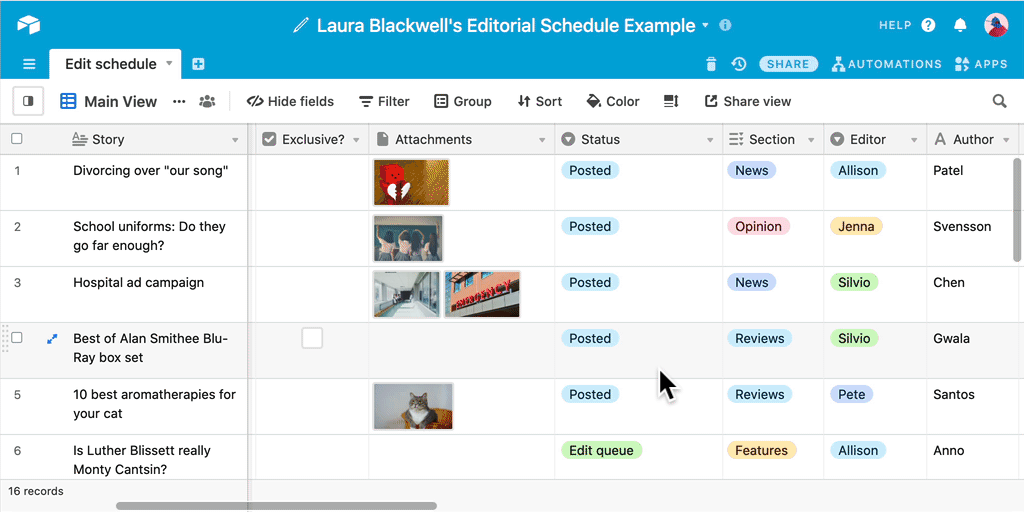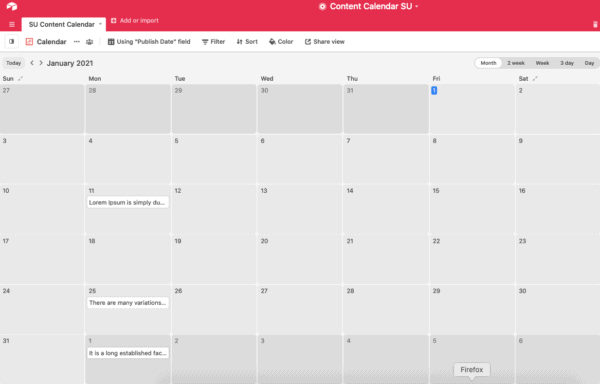

Some examples of views are the Grid view, Calendar view, Gantt view, etc. You can use them according to the way you want to view the data. Customized Views: Airtable provides Customized views.You don’t even need to know SQL, in fact not any kind of scripting. Few common use cases for Airtable are Content Calendar, Project Management, Event Planning, Product Catalog, Job Hunting, etc.įor further information about the services and usage of Airtable, please follow the Official Documentation. You may use it to save, organize, and collaborate on information about anything, including employee directories, product inventory, and even student records. It allows anyone to create a database in minutes. The User Interface of Airtable is Straightforward, Colorful, and User-friendly. Airtable makes it easy to interact with your data while also enabling Programmatic Data Management. It is one of the numerous no-code tools that are gaining popularity. It is easy to use and allows anybody to rapidly construct a database. Airtable Linked Records: Linking Two Existing TablesĪirtable is a progressive Spreadsheet Application with Database Capabilities.

Airtable Linked Records: Converting an Existing Field into a New Linked Table.Understanding the 6 Basic Components of Airtable.Read along to find out how you can Link Records in Airtable seamlessly. You will also gain a holistic understanding of Airtable Linked Records. In this article, you will have an understanding of the process of setting up Airtable Linked Records. These tables related through Airtable Linked Records tend to have a “ Reciprocal Relationship” among them. Airtable Linked Records are the way of establishing relationships between tables. Moreover, Airtable uses features of Relational Databases. Airtable claims to be able to “ organize anything, with anybody, from anywhere.” Data that is related to one another can be linked together. This platform is primarily concerned with data organization and collaboration. And this is where Airtable comes into the picture! It combines the Functionality of a Database and the Style of a Spreadsheet in such a manner that users are constantly aware of what is going on.Īirtable is a Cloud-Based Project Management Tool targeting small and medium-sized enterprises, as well as departments inside bigger corporations. They don’t opt for using databases because these often require SQL scripting skills. If you have any troubles with creating this Airtable content calendar, feel free to reach out at and we’ll be happy to help you.Even after having the requirements to deal with huge chunks of data, organizations still use Spreadsheets for analysis, instead of Databases. It’s called Plainly, and you can book a 15-minute demo to see how it works on the link below. That’s why we created a no-code video generation platform that allows you to set up integrations quickly and generate 1000s of videos in a matter of minutes. For example, we created a workflow where a video will automatically be created whenever you write a blog post. In some cases, you could even have content (like videos) generated automatically, we wrote a few tutorials on that. There is a lot more upgrade possibilities to this workflow, you could add a bunch of cool modules, and even AI that could write the copy for you. You can literally copy everything i did, and get set up quickly.

Setting this up can take around an hour or so, just follow the tutorial and watch the video i created above. Sure, it requires some work but this workflow can pretty much be done for free.Īnd the work part isn’t that hard in my honest opinion. Setting up this automated content calendar can be a great alternative to any other social media scheduling tool. We’ll do this for each social media, so you can have a clear overview of what was posted and what wasn’t. In this module, just pull the Airtable Record ID from the first module, and the only thing you need to modify is the “Status” column at the bottom. One thing i’ll note is that you should be careful when mapping the data and you should make sure that you are mapping the URL of the file and not just the general content field.Īfter each Facebook module, you should put an Airtable / Update a record module which will go back to the Airtable sheet and set the status of the record to “Posted FB”. You can check the video below for a detailed explanation of what goes where. These work only for Facebook pages, and there isn’t a way to do this for your personal profile.Īfter you connect, the only thing left to do is to map the data to Airtable. The first step is to connect your Facebook Page to Integromat. Each medium has to have its own module because that’s just how Integromat and these modules work. There are 3 modules you need for Facebook (Text, Photo, Video).


 0 kommentar(er)
0 kommentar(er)
